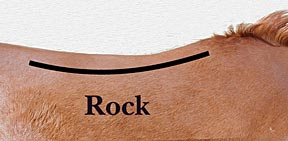When thinking about buying a used saddle, the most important consideration is the fit to the horse and the rider. The nicest looking, well built used saddle in the world is worthless if it is causing either the horse or the rider discomfort.
For the rider, the most important consideration is if there is enough room between the bottom of the cantle and the swell or pommel. Seat sizes between manufacturers vary. A 16″ seat in one manufacturer may equal a 15” or 16″ seat from another manufacturer. Use seat size only as a guideline and make sure you have adequate room for your thigh between the swell and cantle. In addition, the width of the seat should be another consideration. A slim, lightweight rider would feel too spread out if the seat is too wide. A bulkier, heavier rider would not have enough support area if the seat is too narrow.
 If you can’t take the saddle to the horse (or vice versa), at least make a tracing of your horse from about 2″ behind the shoulder blade so you can try it in the gullets of different saddles. This will at least get you into the right width and type of tree that your horse needs. Keep in mind that the saddle still might not fit in other areas of your horse’s back. The rock and twist of the bars also need to fit. About 50% of horses can be fit this way without a problem but if your horse has a back that isn’t considered ‘average’ for that saddle maker, you may end up with a horse with a very sore back.
If you can’t take the saddle to the horse (or vice versa), at least make a tracing of your horse from about 2″ behind the shoulder blade so you can try it in the gullets of different saddles. This will at least get you into the right width and type of tree that your horse needs. Keep in mind that the saddle still might not fit in other areas of your horse’s back. The rock and twist of the bars also need to fit. About 50% of horses can be fit this way without a problem but if your horse has a back that isn’t considered ‘average’ for that saddle maker, you may end up with a horse with a very sore back.
When buying a used saddle you need to keep in mind some of the basics of saddle fit. You can greatly increase your chances of getting a proper fit if you address the two dimensions of the horse’s back.
 First, the front to back curvature of the saddle tree, referred to as ‘rock’ or ‘rocker’, must match that of the horse’s ribcage. Secondly, the change in angle of the bars from the front of the tree to the back, referred to as ‘the twist’, must also match the horse’s ribcage. If the front of the bars don’t have enough flare in them, there won’t be enough room for the shoulder to operate comfortably or for the horse to move his neck laterally. Gaited horses, with their more animated shoulder motion, need even more flare than other breeds. In the rear of the bars there must be enough flare for the horse’s hips to alternately raise and fall.
First, the front to back curvature of the saddle tree, referred to as ‘rock’ or ‘rocker’, must match that of the horse’s ribcage. Secondly, the change in angle of the bars from the front of the tree to the back, referred to as ‘the twist’, must also match the horse’s ribcage. If the front of the bars don’t have enough flare in them, there won’t be enough room for the shoulder to operate comfortably or for the horse to move his neck laterally. Gaited horses, with their more animated shoulder motion, need even more flare than other breeds. In the rear of the bars there must be enough flare for the horse’s hips to alternately raise and fall.
After you determine if the fit is going to work for you an your horse you need to check the saddle over for any signs that something needs to be repaired. Cracked and worn leather can easily lead to an accident on the trail. Also check to make sure the tree is not broken or twisted. A broken tree is not only not much fun for your horse or mule but it can be a very costly repair.

Comments 1
Thank you for helping me understand the rock and twist of saddłe trees, it’s very clear now! Very helpful!